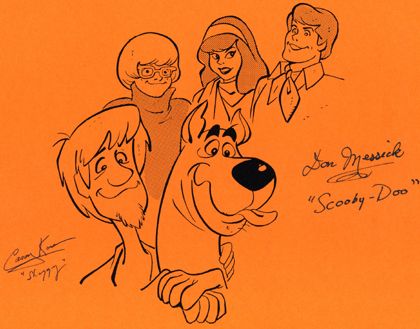
Suspended Animation #324
Kemal Amin “Casey” Kasem was born April 1932 and passed away June 2014. Although primarily known as a radio personality with his popular American Top 40 franchise, he had an active career doing voice work.
In 1969, he started providing voices for cartoon characters like the drummer Groove in The Cattanooga Cats and perhaps his most famous role Norville “Shaggy” Rogers on Scooby-Doo Where Are You?
He went on to provide the voice of Robin in several different animated Batman and Robin appearances from 1968 to 1985 as well as Alexander Cabot III starting in 1970 on Josie and the Pussycats.
In 1995, Kasem quit his role as Shaggy in a dispute over being pressured to do a Burger King commercial as the character and that Hanna-Barbera would not make the character of Shaggy a vegan but later resumed the role in 2002.

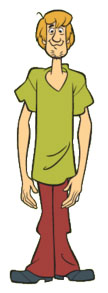 In 1996, he did talk about his relationship with Shaggy.
In 1996, he did talk about his relationship with Shaggy.
Kasem: The first thing I auditioned for was for a tobacco company but I refused to do that kind of thing. My second audition was for the character of Reggie on The Archies. John Erwin got the part and he was much better than I would have been. The third thing I auditioned for was Robin on Batman and I got that. Right after that I started getting a lot of things. At one time I was doing eight to ten shows a year.
When I auditioned for Shaggy, they showed me a picture so I knew he was supposed to be a hippie. I combined two voices: sort of an attitude of Dave Hull who was a disc jockey on KRLA and the actor who played on Our Miss Brooks, Richard Crenna whose character spoke in a high squeaky voice and was always very breathy.
They called me back three or four times and the guy who was auditioning me was an actor who could do a great hippie voice and I thought he was just right for it. I got the part and the show lasted on the network for twenty-three years. They gave me the word “Zoinks” and having him say “like” I guess because of the hippie aspect. I did come up with the “Scoob, ol’ buddy of mine, ol’ pal” thing.
I have never used the word “Zoinks” ever in my everyday conversation. It’s funny but whenever I do interviews, they all want me to do the Shaggy voice.
With A Pup Named Scooby Doo, I just did the same voice but they speeded it up so it sounded a little thinner. They tried to find someone who was younger to do it but they couldn’t find anyone so they just decided to have me do it and speed it up.
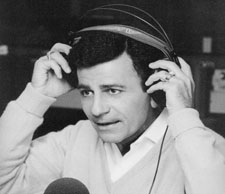 We would usually record one half hour episode of Scooby Doo in a couple of hours on a single day. Occasionally we might be able to do two episodes in a day. It was always fun. They always gave you food at Hanna-Barbera when you were working there. They’d have fruit there and some kind of pastry or something like that. They always went out of their way to be very hospitable to their actors. People loved working at Hanna-Barbera.
We would usually record one half hour episode of Scooby Doo in a couple of hours on a single day. Occasionally we might be able to do two episodes in a day. It was always fun. They always gave you food at Hanna-Barbera when you were working there. They’d have fruit there and some kind of pastry or something like that. They always went out of their way to be very hospitable to their actors. People loved working at Hanna-Barbera.
I occasionally did incidental voices on the series but not often. They just had me do Shaggy which was really great. I guess they wanted to protect the voice and figured they could afford to bring in the other actors. Usually when you do a voice, you do three voices because they don’t pay you anymore for three voices than they do for one. You do a cartoon show and they have the right to three voices out of you before they pay you extra for a fourth voice.
We were always fascinated with some of the voice actors who’d come in who weren’t regulars like John Stephenson and Daws Butler. We had a lot of respect for what the other actors could do. We took everything very seriously. We never kidded about the characters. We enjoyed doing them.
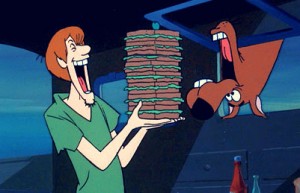 Watching Don Messick do the voice of Scooby and be funny doing it was just terrific. He would get little innuendos and subtleties in his peformance. He made it look easy but you really have to be a pro and have a lot of experience and have a lot of talent.
Watching Don Messick do the voice of Scooby and be funny doing it was just terrific. He would get little innuendos and subtleties in his peformance. He made it look easy but you really have to be a pro and have a lot of experience and have a lot of talent.
So while we had fun at Hanna-Barbera, it was also a no nonsense thing. Nobody spent a lot of time cracking jokes at somebody else’s expense or wasting time by trying to break someone up. We still had fun but we were concentrated on doing the work.
Voice actors are fun to work with because nobody has to worry about make-up or memorizing lines. I think it’s the best kind of acting there is.
I get asked if I believe in ghosts. Absolutely. Absolutely. I’ll give you two examples. My wife (Jean) and I were living in Century City. One night we were in bed with our heads on the pillows looking at each other and from the back of the headboard we heard three solid raps. Just as loudly as if I rapped my knuckles on this table.
We looked at each other with “What was that?” expressions. The bed was not up against the wall. It was seperated from the wall. So we knocked on the wall to see if it had the same kind of sound and, of course, it was not the same because it was plaster not wood. I said that I heard three knocks and she said that she heard two and from then on I believed in ghosts.
The other thing that happened was when we were living in Bel-Air. I’d often forget my clicker for getting in the gate and I’d have to climb over the fence. One night I was in a limo and the limo driver pulled up and said, “How do we get in?” I replied, “Oh, I forgot to bring the clicker key.” He said he would press the button on the intercom but I told him that nobody was at home that night so I would have to climb over.
Suddenly, the gates opened up and nobody had pressed anything. The gates just opened up. And I knew without a doubt that there was nobody home and Jean later said that there was nobody home and the gates just opened up!
So there’s a friendly ghost and every now and then in one section of the house, the lights will go on and off so, I don’t know, there’s probably a friendly ghost around somewhere. Doesn’t bother me though. But after that knock on the headboard, I was truly convinced!
Here’s a rare clip of Casey performing as “Shaggy” on the Jerry Lewis Muscular Distrophy telethon in, I believe, 1987.


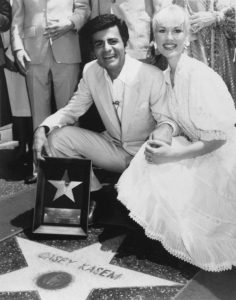
 Jim Korkis is an internationally respected animation historian who in recent years has devoted his attention to the many worlds of Disney. He was a columnist for a variety of animation magazines. With his former writing partner, John Cawley, he authored several animation related books including The Encyclopedia of Cartoon Superstars, How to Create Animation, Cartoon Confidential and Get Animated’s Animation Art Buyer’s Guide. He taught animation classes at the Disney Institute in Florida as well as instructing classes on acting and animation history for Disney Feature Animation: Florida.
Jim Korkis is an internationally respected animation historian who in recent years has devoted his attention to the many worlds of Disney. He was a columnist for a variety of animation magazines. With his former writing partner, John Cawley, he authored several animation related books including The Encyclopedia of Cartoon Superstars, How to Create Animation, Cartoon Confidential and Get Animated’s Animation Art Buyer’s Guide. He taught animation classes at the Disney Institute in Florida as well as instructing classes on acting and animation history for Disney Feature Animation: Florida.




















































Another 1969 role voiced by Kasem was the villainous ‘Dexter Carter’ in the somewhat-infamous HOT WHEELS cartoon show.
When I was commuting to Wayne State University I used to drive by a billboard on I-94 picturing Casey Kasem with the caption: “I went to Wayne State! Great school!” I used to say “Zoinks!” every time I passed it. So I really did use the word in everyday life for a few years.
When Scooby-Doo was brand new, it was obvious to a lot of us that the human characters in the cartoon were based on characters from “The Many Loves of Dobie Gillis”. Fred was based on Dobie, Daphne on Thalia, Velma on Zelda, and Shaggy on the goofy beatnik Maynard G. Krebs. I don’t know if Bob Denver’s portrayal of that character had any impact on Casey’s performance as Shaggy, but Maynard’s voice used to crack when he exclaimed the word “Work!” in horror, much as Shaggy’s does when he says “Zoinks!”
I respect Casey for sticking to his principles when he turned down that Burger King ad, but Shaggy isn’t really Shaggy without the junk food. Now, Matthew Lillard — that guy really nailed the character.
Unfortunately Casey’s last years were fraught with health issues, dementia, and acrimonious legal disputes between his wife Jean and the children from his first marriage over power of attorney and visitation rights. Both parties blame the other for causing his death. Casey’s remains lie in an unmarked grave in Norway, where he had never been in life, with little prospect of repatriation until the unlikely event that this bitter family feud is resolved.
Joe Dante’s 2003 live-action/animation “Looney Tunes: Back in Action” isn’t quite the sum of its parts, but the film has a few quite brilliant moments. One of the picture’s highlights is a brief but eventful scene set in what is supposedly the Warner Bros. commissary. This sequence is crammed with familiar faces and characters, as well as some great throwaway gags, including the quick sight of a table with an animated Shaggy (voiced by Casey Kasem) and Scooby (here Frank Welker) criticizing a live-action Matthew Lillard for his weak performance as Shaggy in the “Scooby-Doo” feature film. A very funny idea; the audience roared at this.
There was no question that Dobie Gillis provided inspiration for some aspects of Scooby-Doo, but reading the original Max Shulman Dobie short stories reveals that only one of them resembles the TV show, and only in the names of a few characters. The TV series added a lot of extra characters (just as David Levy added specifics to Charles Addams’ “Addams Family” one-panel cartoons). The Dobie Gillis TV characters owe a lot to Archie comics, which in turn had their roots in Henry Aldrich.
Hanna-Barbera gets a lot of stones cast for “rip-offs” but let those who are without ripping off cast them first. At least they never denied it.
For awhile there the gag was, “Scooby-Doo is Dobie Gillis plus Marmaduke.” Then it was, Scooby and Shaggy are stoners and Daphne and Velma are, um, alumnae, yeah, that’s right, they went to the same school.
What do you mean, they never denied it? They denied it all the time. But there’s no denying that they breathed new life into the characters that inspired them and often rose above the source material.
I remember telling some younger colleagues who had grown up with “Saved by the Bell” that that show had many elements in common with “Dobie Gillis” (Dobie was a good-looking blond guy, he talked to the camera, he was girl crazy, he had a goofy best friend, etc.). They had never heard of Dobie Gillis, but of course they knew all about Scooby-Doo.
And Archie and Henry Aldrich in turn owe their genesis to the genre of juvenile fiction that came into being after the imposition of child labour laws opened up the market for it by giving young people more time to read.
“What has been will be again, what has been done will be done again; there is nothing new under the sun.” — Ecclesiastes 1:9
“Animation is built on plagiarism…. you take away our right to steal ideas, where are they gonna come from?” — Roger Myers Jr.
I’m guessing that listen to Picasso’s quote: “Real geniuses steal!” Although, I have heard art critics have heavily criticizes the artist works as much as some animation critics (and a hypocritic who did an awful early Canadian CGI that might be worse than most parent code-era cartoons) criticizes H-B.
Perhaps “never” in this is too specific, but in their autobiographies, both Hanna and Barbera discuss the sources of their major shows. I have seen and heard them speak freely about their source inspirations. The court will withdraw the word “never.”
Barbera characteristically danced around it more (he had the standard “did the Honeymooners have a Polarock camera?” comeback) but they rarely put on pretentious airs about their “journey” and “vision.” Meanwhile, there were few if any major or mid-level TV or film animation studios who didn’t “borrow” from themselves, public domain, or other works–either through disguising the “tribute” or satirizing it.
In 2009, Casey did the voice of Shaggy in a video entitled “Peter Kay’s Animated All Star Band.” This video featured the stars of several children’s TV shows (Thomas the Tank Engine, Bob the Builder, Teletubbies, Paddington Bear, Spongebob , the Thunderbirds and many others) singing a medley of rock songs. Shaggy and Scooby sing a couple of lines of Fleetwood Mac’s “Don’t Stop.” Kasem agreed to do the part if Shaggy was shown eating vegetarian food. The video was to promote a record to raise money for a children’s charity. I believe that this was his final performance as Shaggy.
https://vimeo.com/17811592
That was Matthew Lillard voicing Shaggy in this one.
FWIW, according to Peter Kay, it was Casey Kasem:
https://web.archive.org/web/20110726183304/http://i.imagehost.org/0813/paperclippingpeterkay.jpg
Kasem’s last performance as Shaggy in a DTV Scooby movie was 2009’s “Scooby Doo and the Samurai Sword”
And Kasem’s last animated performance was voicing Shaggy’s father in “Mystery Incorporated”. His last line in the final episode to Shaggy really felt like Casey passing the torch to Matthew Lillard. It was both touching and poignant at the same time.
Was that the “Char-Gar-Gothakon” episode? It featured Harlan Ellison (doing his own voice), criticizing Shaggy’s starting his sentences with “Like…”
Nic is referring to the final episode of the series, in which the destruction of the Ultimate Evil creates an alternative universe where Shaggy’s parents, who had always regarded him as a useless slacker, are now proud of him. Char-Gar-Gothakon (“the beast that hath no name”) was in a Season 1 episode that Casey Kasem wasn’t in. It was the first episode of “Mystery Incorporated” that I saw, and as a fan of both H. P. Lovecraft and Harlan Ellison from way back I absolutely loved it. “Mystery Incorporated” is a clever, complex, well-written and very funny animated epic — a true masterpiece.
Agreed. Been enjoying those episodes recently on the Boomerang app.
Don’t think it gets remarked upon enough that Scooby has outlasted every single cartoon from the 60s and 70s. You don’t see kids with Rocky and Bullwinkle backpacks
Goes back to what I said about the resiliency of some properties. Scooby-Doo is a lot of things, but it has a great sense of itself, laughs at its own format and is at its best when it does not try to be important and vital to the art of the genre or the world in general. It just entertains.
And it keeps on going while its detractors growl about those meddling kids, which is now part of our language. The quiet power of the “trivial throwaway.”
make sure you see Casey do the Top Ten countdown on Letterman video
Why did Kasem retire in 2009?.
Where does that 1996 interview come from?